Non-native species are either intentionally or accidentally introduced and they may either be invasive or non-invasive. If a species turns out to be invasive it can have a negative impact or a neutral impact or perhaps even a positive impact.
In addition species can expand their range naturally eg. Collared Dove or in response to climate change as is the case with some bush-crickets that are now well-established in Nottinghamshire but which were previously restricted to the southern counties.
Much of this information comes from the Non-native Species Secretariat website, which is a seemingly limitless resource.
There is also a massive amount of resources on the diseases of trees at the Observatree Website.
Elm Zig-zag Sawfly Aproceros leucopoda
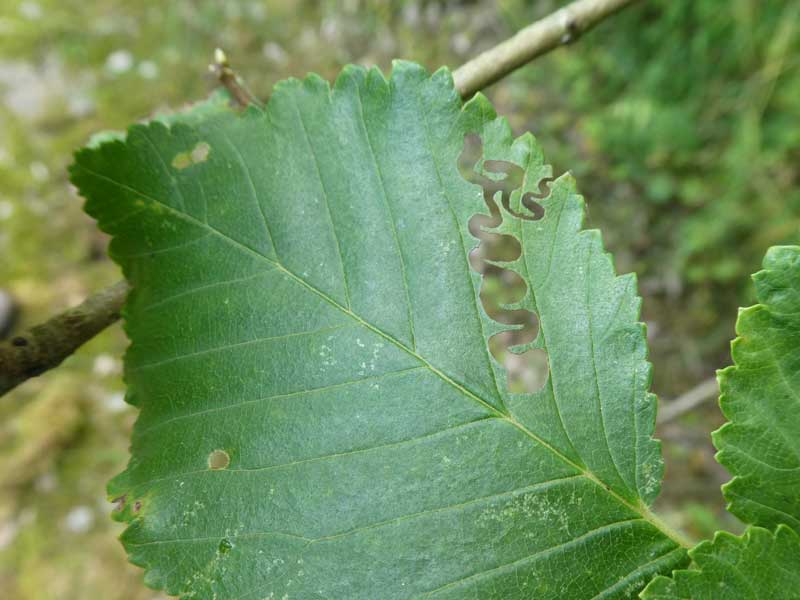
N Pinder
This sawfly made it to Europe in 2003 and to England in 2017 or earlier. It is now widespread in SE England. It munches on all species of elm and is capable of defoliating them severely but it is thought that in the relatively cool conditions here their development will be slower than in warmer climates and the populations will not become high enough to cause severe damage. Its presence though will compete with White-letter Hairstreak and other native organisms that use elms.
The adult sawfly is largely black with white legs but the distinctive meandering grazing pattern should be enough to track their distribution.
Red-eared Terrapin Trachemys scripta elegans
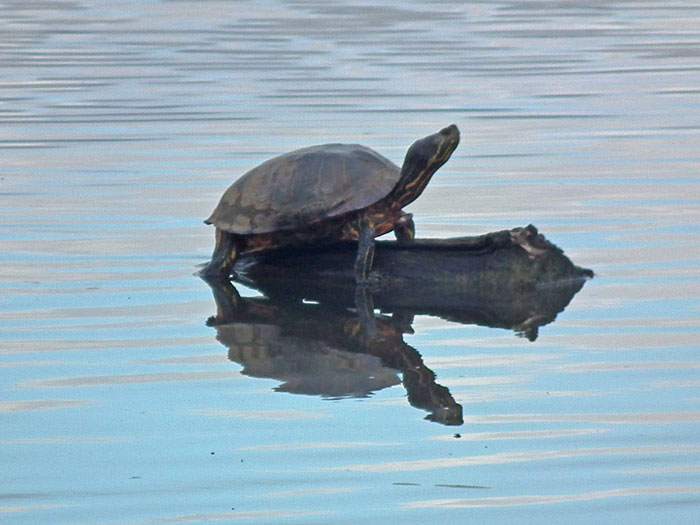
N Pinder
Native to the southern USA and sold as a pet in Britain, they were especially popular during the 1980s during the Teenage Mutant Ninja Turtles craze. When sold they are the size of a penny coin but when full grown they reach 30cm in length and have a powerful bite. Many were thrown out into the local ponds and with a lifespan of thiry to forty years, there they remain as a potent predator of small fish and invertebrates.
The good news is that they do not appear to breed in the cold waters of the UK and it is expected that they will eventually all die out without further introductions. However, they are still being sold (£70 a pair on Preloved Oct 2017) so further illegal introductions are probable. Interestingly, several adverts on the same site were appealing for unwanted terrapins for rehoming on private ponds which seems like a better destiny for outgrown pets.
They are in many largish ponds such as that at Skylarks reserve at Holme Pierrepont Attenborough nature reserve and Iremongers Pond at Wilford. They can be easily seen on sunny days when they bask on logs and emergent rocks but they will soon return to the water if disturbed so a cautious approach and a pair of binoculars will help with good views.
New Zealand Pigmyweed Crassula helmsii
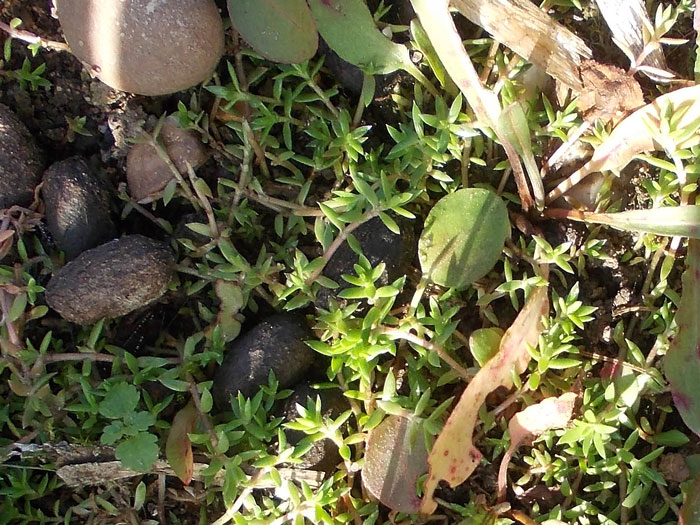
N Pinder
Also known as Australian Swamp Stonecrop, this is now widespread around the margins of almost all (if not all) the gravel pits along the Trent Valley and is most obvious as a green carpet just above the waterline where it grows so densely that it out-competes other plants and reduces diversity.
It was introduced as an oxygenating plant early in the twentieth century but since the 1970s has spread rapidly. As well as the terrestrial form, it can be an emergent or submergent when it is less easy to spot.
Chilean Giant-rhubarb Gunnera tinctoria
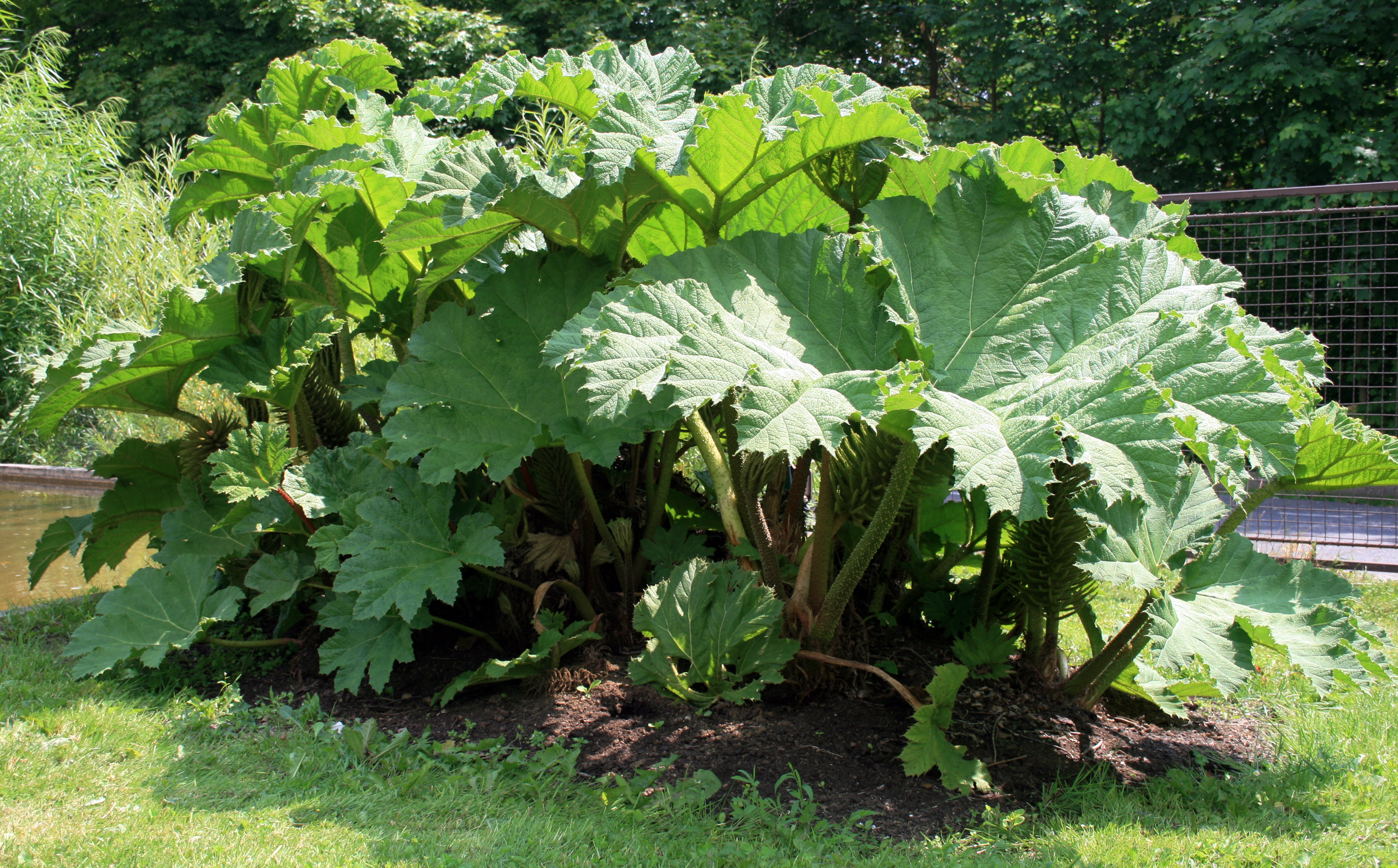
By Karelj (Own work) [Public domain], via Wikimedia Commons
Only found at a couple of locations in Nottinghamshire (Newstead and Worksop) this native of South America is one of two species that are established in Britain which were introduced as ornamentals and are now found at scattered locations throughout the UK. They can be very invasive and form dense colonies beneath which nothing else can grow as the leaves are vast and cast deep shade.
Water Fern Azolla filiculoides
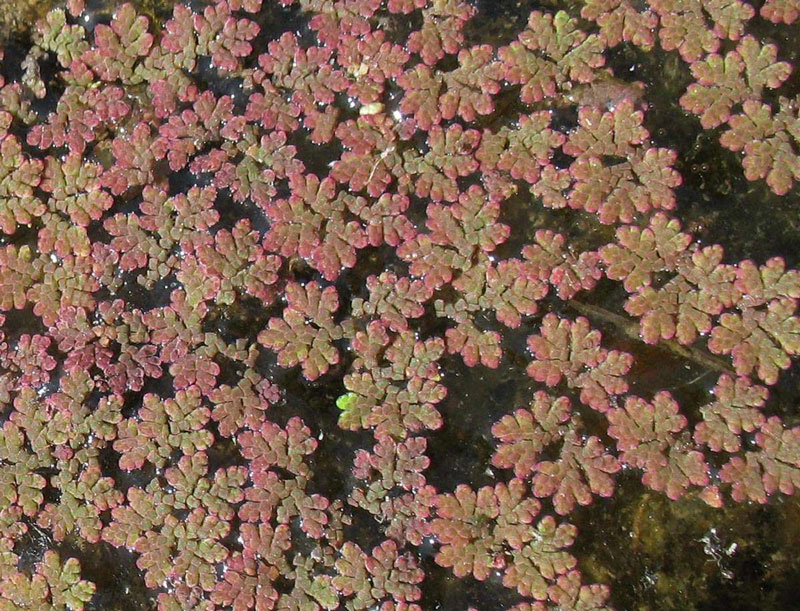
N Pinder
A native of the Americas, it was first recorded in Middlesex in 1886 and is now found in ponds, lakes and slow-flowing waters throughout Britain though it is mainly southern. It may have been a native to Britain during a previous interglacial period.
There are recent records for the Nottingham Canal around Awsworth, at West Bridgford, near Bingham and near Staythorpe power station. It seems to be absent from the Grantham Canal in Nottinghashire though it is found in several sections near Grantham itself.
In favourable conditions, Water Fern can cover large areas of a water body completely and to a depth of up to 30cm when it blocks out light preventing photosynthesis by other plants and preventing the movement of organisms such as odonata larvae and newts to the surface. Dogs sometime mistake the blankets for dry land and have been known to drown and it restricts boating and angling.
No native species control Water Fern though a North-American weevil, resident in Britain since 1921, feeds on it but doesn't control it effectively
Signal Crayfish Pacifastacus leniusculus

By Astacoides (Own work) [CC BY-SA 3.0 (https://creativecommons.org/licenses/by-sa/3.0)], via Wikimedia Commons
Native to North America and found in a variety of freshwater habitats. In the 1970s a Dorset farmer diversified into the rearing of crayfish and imported this species hoping that its consumption would catch on. It is a highly mobile species and capable of travelling overland in damp conditions. This is one of several North American crayfish species that are now extant in Britain, two of which are in Nottinghamshire, Spiny-cheeked at Attenborough and Red-clawed at Nottingham University ponds. All of them can spread crayfish plague which is fatal to our native White-clawed Crayfish.
By the 1980s the Signal Crayfish had been found in the River Greet and is now in many Notts waters including the Trent, Leen, Devon, Dover Beck and Soar. It is the Leen population that is of most concern as this watercourse hosts a nationally important population of White-clawed Crayfish and efforts are underway to control and eliminate the non-native species.
Bloody-red Mysid Hemimysis anomala
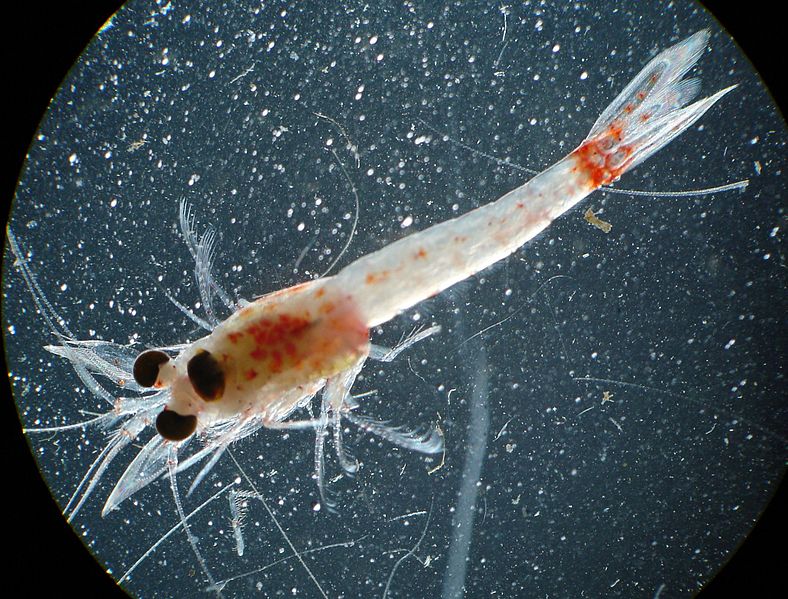
By S. Pothoven, Great Lakes Environmental Research Laboratory (National Oceanic and Atmospheric Administration) [Public domain], via Wikimedia Commons
This is a small crustacean, 6-13mm long that resembles a shrimp and is native to the Caspian Sea region. It has been spread intentionally by anglers believing it would serve as a fish food and accidentally in ballast water. Large agglomerations swarm near the surface during darkness and appear as a reddish-tinged cloud. They avoid sunlight and shelter in stony or rocky crevices. In Nottinghamshire it is established in the Trent around Nottingham having first made it to the Holme Pierrepont rowing course presumably on boats and equipment from international venues.
The sheer number of mysids assuming a new link in the food web will, it is feared, upset the ecology of populated waters significantly and magnify the bioaccumulation of contaminants, stressing organisms at a higher trophic level.
Asian Clam Corbicula fluminea
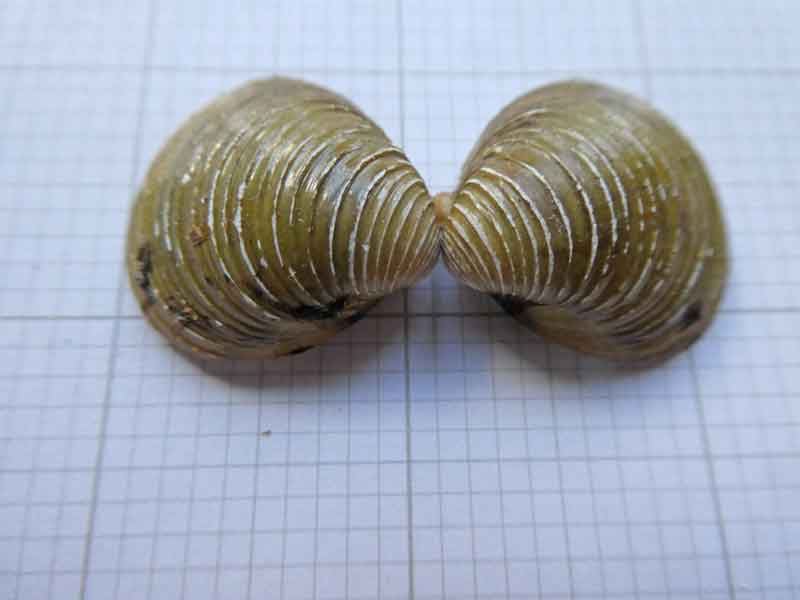
N Pinder
Native to southern Asia west to the Mediterranean and much of Africa, it is now found in both South and N. America and Europe and is established in the Trent and Soar. Shells have been found along Clifton Grove after the storms of winter 2019-20.
The species doesn't figure prominently on the NNSS pages and its threat to the environment is not clear though it can form dense mats on the river and lake bed which forces native species out and it is said to block up water intakes like the Zebra Mussel. It reproduces freely as a highly fecund hermaphrodite.
It is typically about 25mm in diameter with a greenish tinge and is strongly ridged.
Japanese Knotweed Fallopia japonica
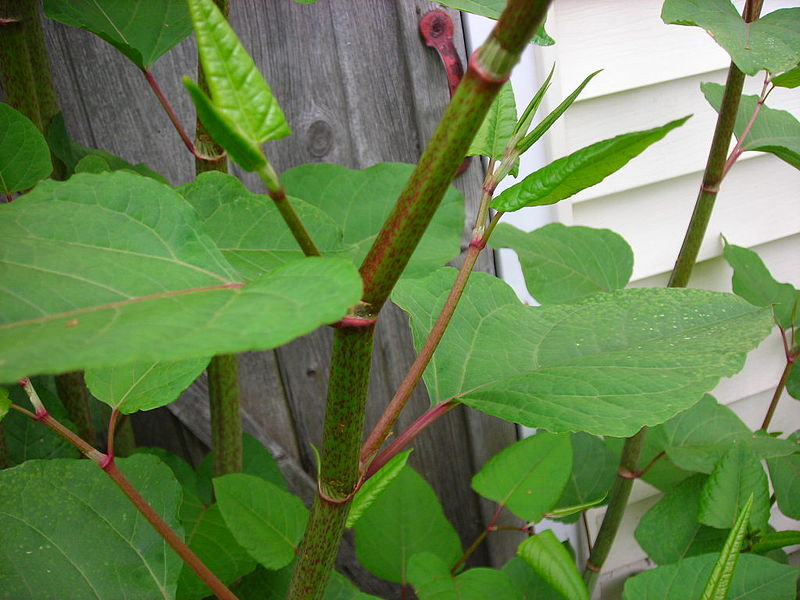
By Ancatdubh43 at English Wikipedia [Public domain], via Wikimedia Commons
Found in at least six widely scattered locations in rural Rushcliffe and more common in urban areas and near watercourses this native of Japan, Taiwan and northern China is notoriously difficult and expensive to eradicate and able to grow through ashpalt. It does not set seed in this country but can regenerate from fragments of stem or rhizome. It suppresses all other plants by forming 2 metre tall, dense stands which die back in winter.
It was introduced in the early nineteenth century as an ornamental plant and it is not illegal to have it on your property but it is an offence to allow it to grow in the wild and if it causes a nuisance in the neighbourhood, you can be prosecuted under the Anti-social behaviour, Crime and Policing Act 2014! Also the value of the property is likely to be much reduced as the cost of elimination of the plant is so high with the materials arising being hazardous waste and needing to be taken to a specially licensed tip.
Giant Hogweed Heracleum mantegazzanium
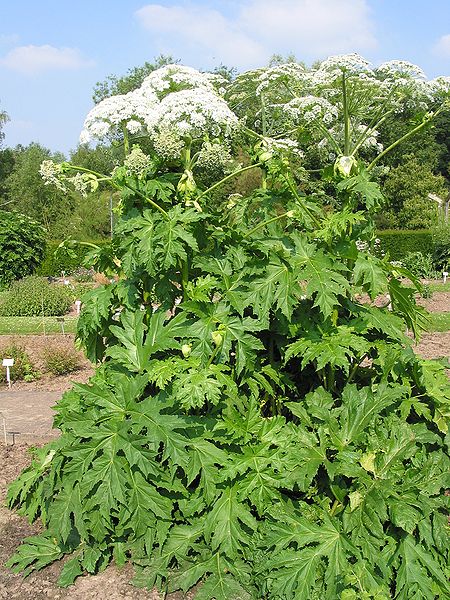
By Jean-Pol GRANDMONT (Own work) [CC BY-SA 3.0 (https://creativecommons.org/licenses/by-sa/3.0) or CC BY 3.0 (http://creativecommons.org/licenses/by/3.0)], via Wikimedia Co
In Rushcliffe this native of Azerbaijan is present in at least five widely-distributed sites but often with a connection to parks where it was perhaps originally introduced as a curiosity. It is a monstrously big plant which dwarfs even the biggest Common Hogweed plants (and these can be two metres tall) with massively thick stems the diameter of a man's wrist.
It was first introduced in 1817 and was naturalised by 1828. It reproduces entirely by seed which is produced only once in the plant's lifetime.
Ecologically, this plant causes little damage other than to dominate where it grows but it is a serious health hazard to humans as its sap contains furanocoumarins which, if it gets onto skin, causes painful burns and blistering and reddening when exposed to sunlight. The blistering can return for many years with new exposure to sunlight. The condition is called phyto-photodermatitis. Contractors wearing full personal protective gear can still be susceptible to the complaint as the hairs of the plant are contacted when the clothes are removed.
Himalayan Balsam Impatiens glandulifera
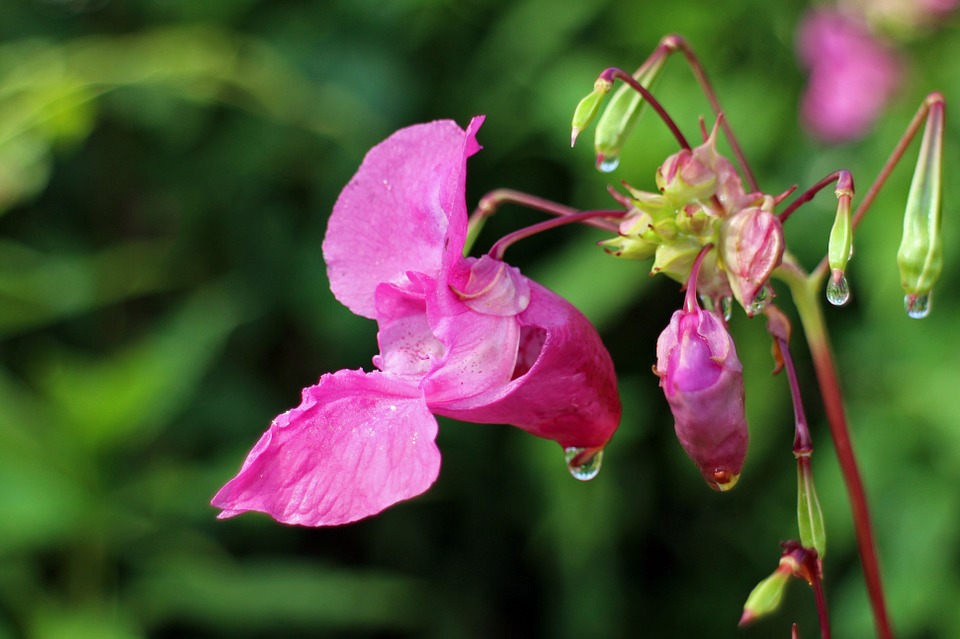
Creative Commons Zero - CC0.
Also called Indian Balsam and more rarely, Policeman's Helmet. It originated in the western and central Himalayas and is now found pretty much exclusively in damp habitats usually close to a watercourse. It is very common along the Trent and in other parts of Rushcliffe such as the Kingston Brook and at Normanton on the Wolds.
It forms extensive patches up to two metres tall and prevents anything else growing beneath it but in winter it dies back leaving bare soil that is prone to erosion. The seeds are distributed explosively by the sudden springing of the pod as it dries.
It is quite easy to eliminate by pulling the plant before it has seeded but this requires volunteers and somewhere to dispose of the uprooted plant as well as coordinated effort to prevent recolonisation.
It was introduced as a garden plant and found in the wild in 1855. It is now widely distributed throughout Britain right up the the Shetlands
Harlequin Ladybird Harmonia axyridis

By Charlesjsharp (Own work, from Sharp Photography, sharpphotography) [CC BY-SA 3.0 (https://creativecommons.org/licenses/by-sa/3.0)], via Wikimedia Commons
First found in Britain in 2004, this Asian species had been anticipated for some time having been deliberately introduced to several European countries as a biological control agent and then predictably transferred to Britain as a stowaway among fruit, vegetables and packing cases.
The species was well known as an invasive, since it was deliberately introduced into North America in 1916 and subsequently into the rest of America, South Africa and the Middle East. It has spread rapidly in Britain by about 100km a year.
For several years the prediction that it would devastate our native species of ladybird seemed exaggerated and although there were large aggregations of the Harlequin in late autumn, the numbers in subsequent years did not appear to be out of hand. However, since around 2015 the Harlequin has become the most common species, displacing the Seven-spot. Since it arrived, the 2-spot declined by 44% and the species does seem to be a true threat to the native species.
Floating Pennywort Hydrocotyle ranunculoides
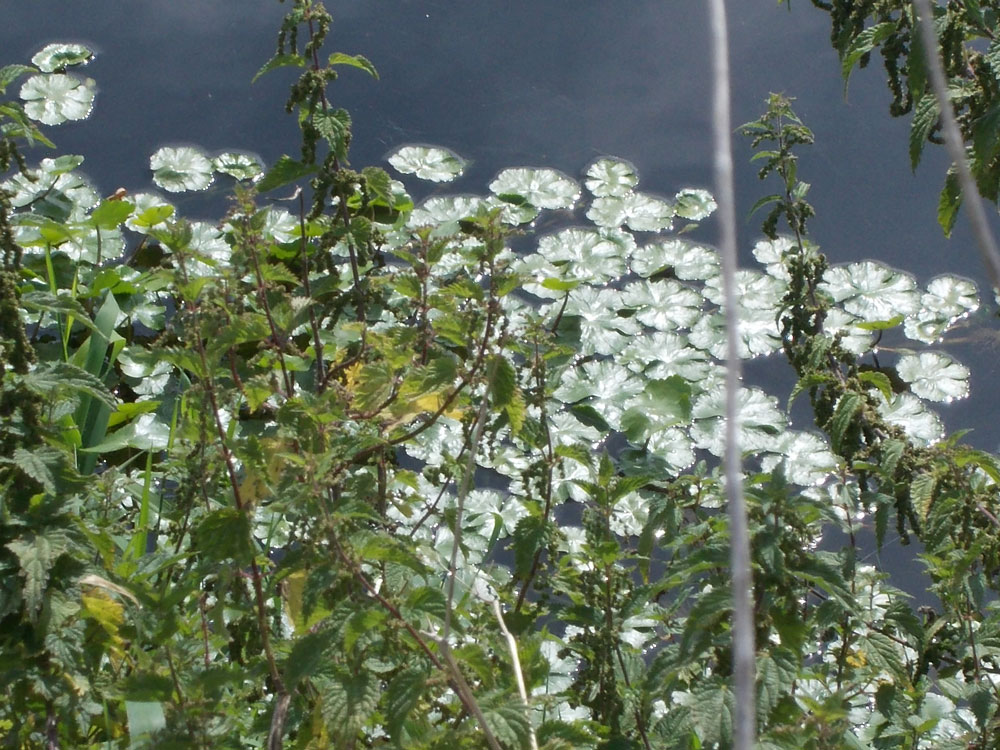
N Pinder
First recorded in the wild in 1990 in south Essex, it is present in Rushcliffe on the River Soar and has colonised the River Trent but the Environment Agency take the threat from this American plant very seriously and have eliminated the majority of the population. There are particular efforts to avoid in getting downstream and into the low-lying ditches of the lower Trent where it would thrive and seriously impair the ecology of these static or slow-flowing water bodies.
It was deliberately introduced to Britain as a garden pond plant. It forms a dense growth on the water surface, restricting photosynthesis of submerged plants and the movement of boat traffic. In winter it dies back and increases nutrient loads massively.
Marsh Pennywort Hydrocotyle vulgaris is a native species, similar in appearance but it grows on wet ground and not as a free-floating plant.
Horse-chestnut Leaf Miner Cameraria ohridella
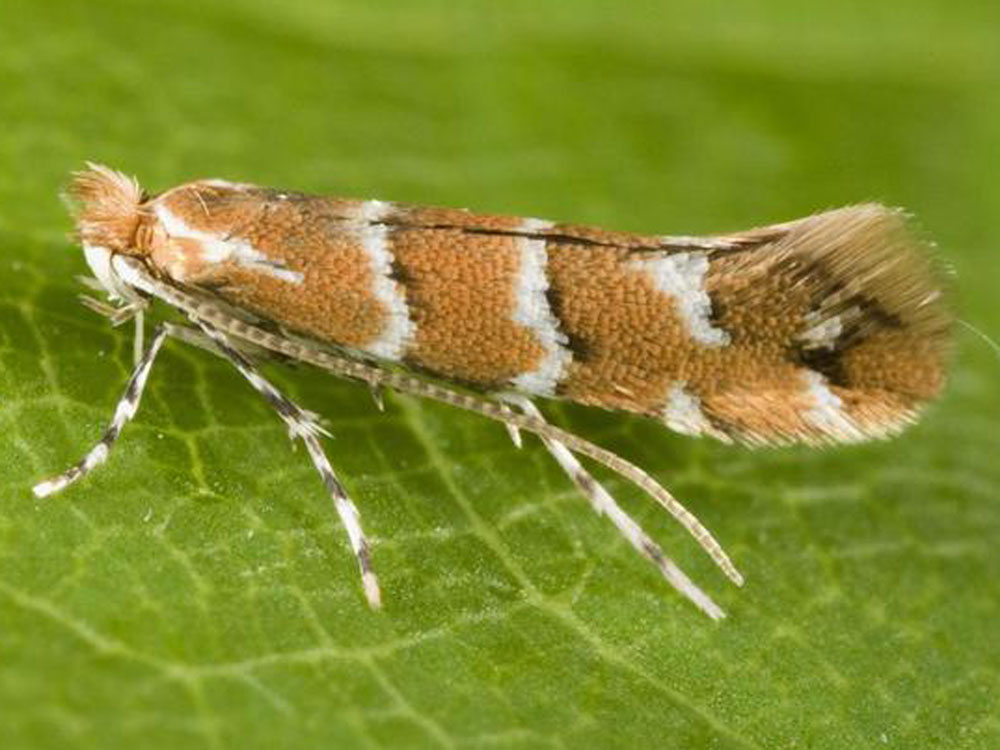
First recorded in Britain in 2002, it rapidly spread across the country and is now ubiquitous in Nottinghamshire. It was initially feared that its depredations would spell the end of the Horse-chestnut in Britain but, although the trees become virtually mined out in late summer, giving them the appearance they would not normally get until autumn, the trees manage to photosynthesise sufficiently for them to survive.
Its origins are in the Balkans and it seems to have spread locally from a native population of Horse-chestnuts to ornamental varieties. Its rapid expansion across the continent is believed to have been assisted by the unintentional transport of leaves hosting the pupae.
Asian Hornet Vespa velutina
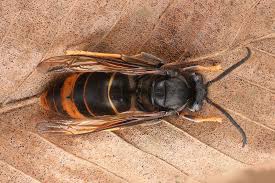
Creative Commons Attribution-Share Alike 2.0 Generic
A real threat to honeybees in particular, this hornet, that has spread into mainland Europe from an accidental introduction into France in a cargo of pottery from China, seems to have been contained in the UK. Publicity about the insect has resulted in notifications of sightings and immediate action to eradicate the colonies. Confined to Sussex and Kent, in December 2024, their spread was reported as having been stopped.


